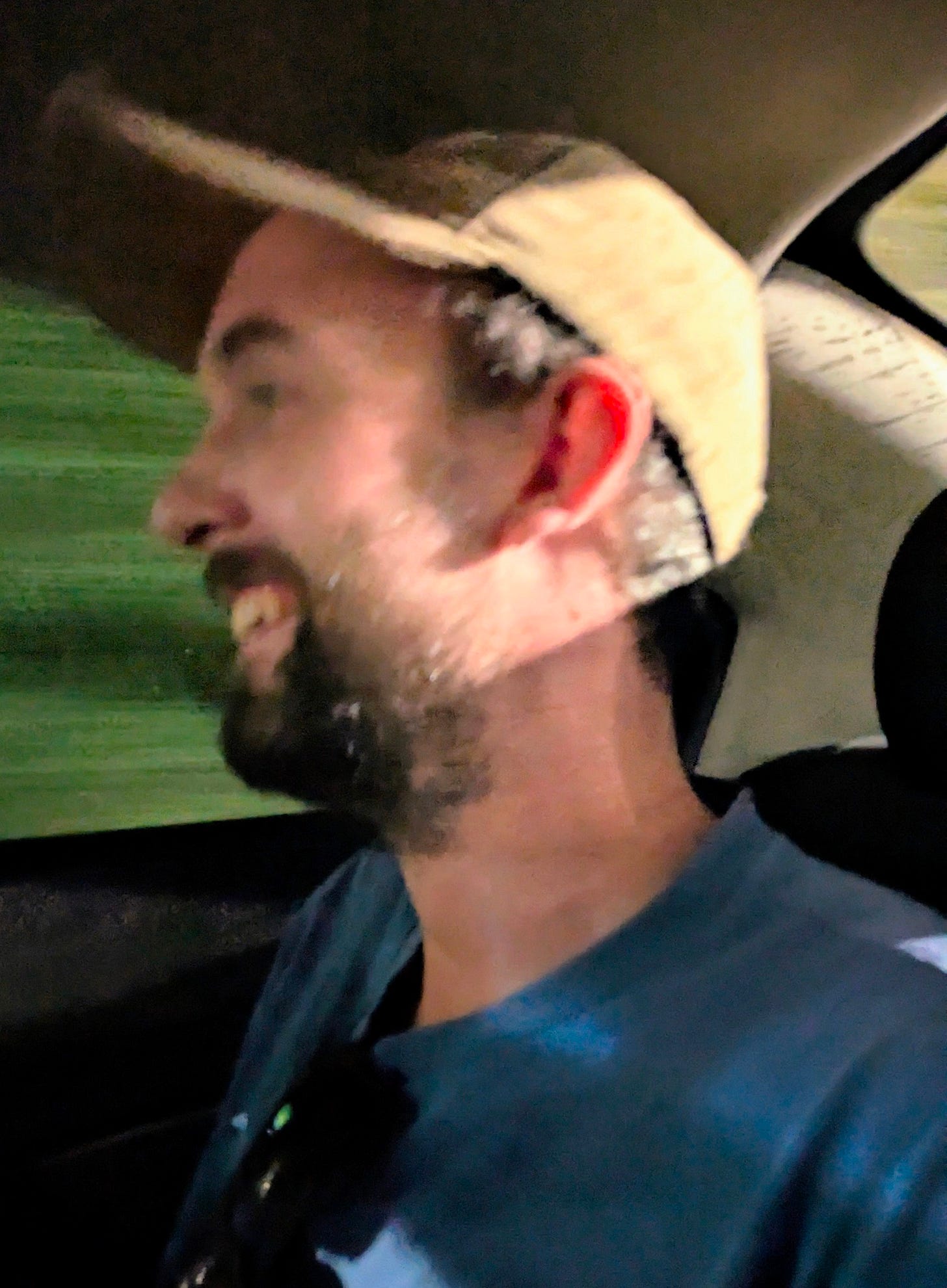Accepting spirits from strangers, a cautionary tale
“The horses were so fat! They're not supposed to be that fat!"
I'll be honest, when our new friend Edwin asked us to sit with him to practice his English, it was me who said yes – mainly because the bar we were in was full to bursting, and it meant we could share his table, at least until our food arrived.
We were in the Mercado del Rio food court in Medellín, on the night of a big football match between Colombia and Brazil. Every corner shop, restaurant, bar, even taxi car bonnet we walked past that evening had a screen and a crowd around it, and most people in the mercado had been drinking steadily in the build up – as had we, coincidentally. After a day spent exploring Medellín’s city centre, admiring the many Fernando Botero statues dotted around the main plaza (named after the artist) and nearby museums, we had gently crawled the bars of the very hip and industrial Colombia/Perpetuo Socorro neighbourhood.
Now it was time to eat, and the food market seemed like the ideal place for something casual – but we hadn’t bargained on the cinema-sized screenings luring in half the city’s Colombia fans. By the time we arrived it was standing room only, so we perched by the bar of an Indian food stand and stood absorbing the sounds of a thousand people’s emotions, until half time allowed us to hear ourselves speak again.
That’s when Edwin approached us. Could he buy us a drink? We were white; he was learning English and wanted to practice. Of course, we said. The drinks weren’t necessary but we’d happily chat to him. Then we sat down with him and his girlfriend, and of course the drinks came anyway.
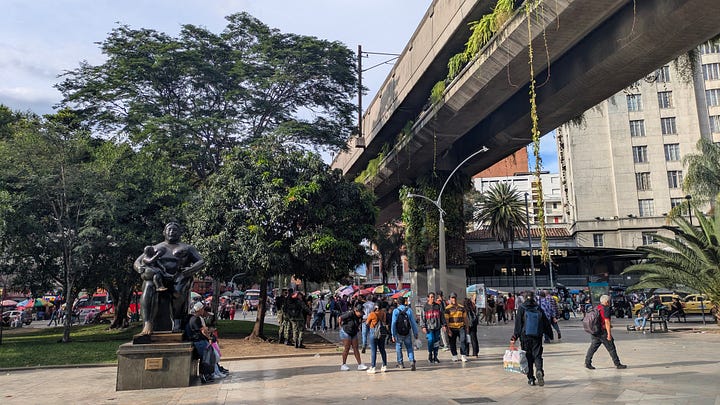
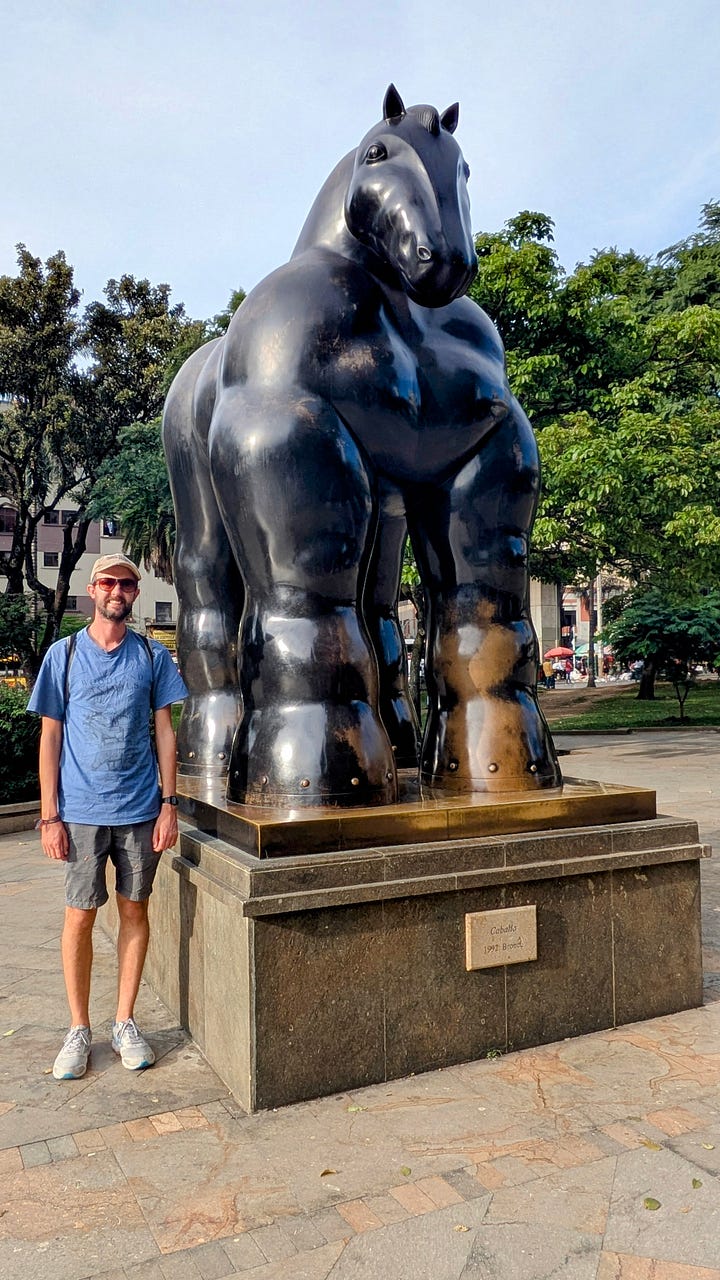
Edwin was a sweet guy, excited to meet a pair of foreigners and ask us how we liked his city. But he soon clammed up. I quickly realised he didn't really speak much English after all and was likely regretting the invitation, but our food had arrived to the table and we weren’t moving on any time soon. And so he masked his awkwardness by ordering a troubling number of drinks for a man whose recent gastric band surgery meant he physically couldn't line his stomach very well.
In all the years I've known Dave I think I've seen him drink a shot once, maybe twice? And not in a very long time. He loves a beer, there's no doubt about that, but Dave’s just not a spirits kind of guy. And yet, for reasons I still don't understand, he decided that tonight would be the night to change all that.
Edwin really wanted us to try aguardiente, Colombia's national spirit – he absolutely insisted, in fact. Four small tumblers arrived and the four of us cheers’ed – I did my best, but only managed about half the glass, because that stuff is serious. It tastes a bit like home-brewed sambuca, but more acidic. An acquired taste and one I don’t share. But Dave, despite also hating sambuca and all things aniseed, kept finishing the shots that Edwin bought him. And because Dave kept finishing the shots, more kept coming, until Edwin eventually came back with an entire bottle of the stuff.
Despite having no shared language, and neither of them being able to string a sentence together by this point, Dave and Edwin were soon the very best of friends and announced that we would all be going out to a party together in Edwin's neighborhood that night. Then Edwin's partner pointed out that both she and Edwin were supposed to be starting work at 5.30am… Edwin was in fact an engineer, with responsibilities by the sounds of it that meant he had quite an important meeting at 7am. Poor Emperatriz looked to me to be long-suffering. But luckily for both of us, the bar was finally closing – Colombia having lost the game some time ago, clearing everyone else out – so I ordered an Uber while I had my chance and bundled Dave into it.
I did worry that Dave might be sick in the Uber. The driver kept looking at us in the wing mirror with concern, not helped by the fact Dave was giggling uncontrollably to the point of actual tears. When I asked Dave what was wrong, he kept talking gibberish about horses: “The horses were so fat! They're not supposed to be that fat because they're meant to run around! Why were they so fat!” It took me a moment to clock that he was talking about the Botero statues, of course. Those marvellous, bronze, chubby horses. Dave really wanted me to tell the driver about the fat horses, and while I speak decent Spanish I still didn't quite have the words to explain away this one.
Things descended when we got back the Airbnb. Dave wanted to make us a cocktail; I suggested a cup of tea. We settled on a beer and a water, both for him, and he took about one sip of each before unlocking the next stage of the Aguardiente journey: the bathroom floor era. He spent several hours oscillating between throwing up and lying on the bathroom floor, softly moaning to himself and shouting “SORRY” to me until I told him to shut up and let me sleep.
This continued the following morning, which was a problem because we were booked in for a Pablo Escobar-themed city tour at 1pm (more on which later). I knew from the moment of the fat horse giggling episode the previous night that we weren't going to make the tour, but Dave kept insisting he'd be fine until the very last minute – I’m talking literally 30 minutes before the start of the tour – when he eventually conceded that maybe he wasn’t in a fit state to go out anywhere after all. I sent a message from Dave’s phone to the tour company feigning illness (not completely untrue) and suffice to say they weren’t happy about it.
While Dave was busy suffering, I got on with my life. I called my parents, I called my friend Anthony. I made myself an elegant breakfast of fruit and yogurt. I dialled in for my online Spanish lesson. My teacher has been making me revise the pretérito imperfecto tense lately which meant I could practice phrases like “Dave used to drink beer but now he drinks spirits” and “last week we were looking forward to the tour but today I am going to have to cancel”, and so on and so forth.
Then I decided enough was enough, took myself out for a coffee and gave Dave a bit of an ultimatum: to meet me at 4pm or I was going out to see Medellín’s famous comuna 13 neighbourhood without him. Dave rallied, but we’ll never know whether or not Edwin made it to his 7am meeting.
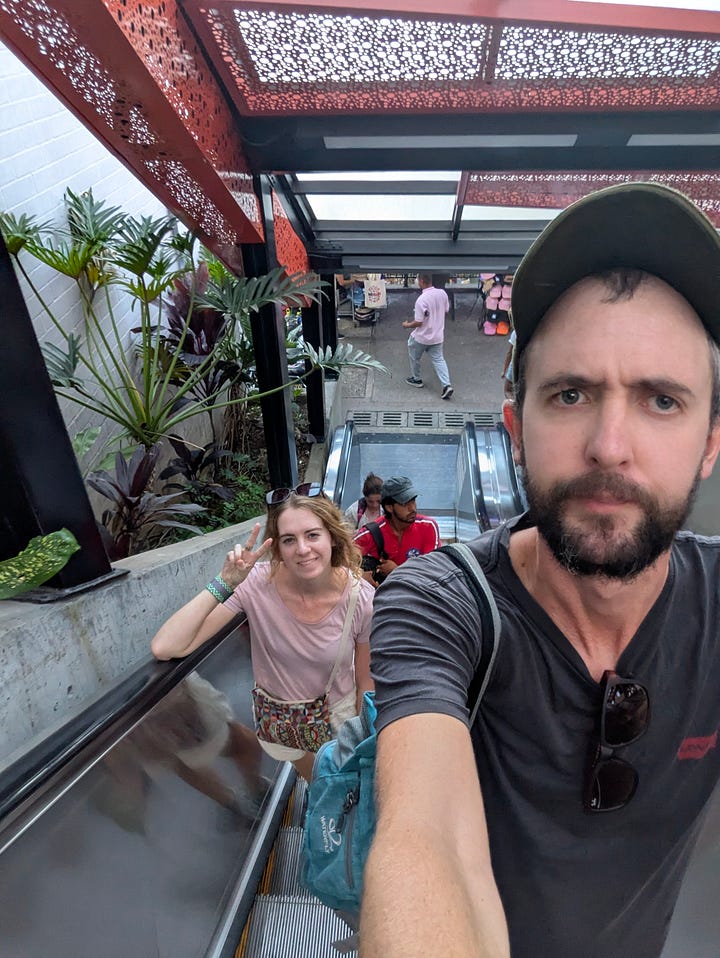

From the cocaine valleys of San Agustín it was northwards to Popayán, a city famed for its white walls and hailed (by some very ambitious tourism board employees) as a competitor to Arequipa in Peru for its Spanish colonial charm. We found it a bit more real than than its Peruvian contemporary, in all senses of the word: a regular working town devoid of gringos that was pleasant enough, if a little run-down. I don’t think Arequipa or Cusco have anything to worry about.
The problem with committing to white walls and creating an identity around that is you kind of have to keep them clean and free of artless graffiti tags, or else the place starts to look sad. Students stopped us to ask what we thought about the place and it was clear they weren’t too enamoured themselves.
We'd planned a city tour, but the organisers (more students) never showed up, so we took ourselves around instead with some input from Wikipedia on the top sights, namely, seven notable churches (we took in one or two) and a clock tower, featuring a clock face made in England (who knew!). The original clock tower was built next to the old cathedral in the 1670s, but like most things in Popayán that was destroyed in an earthquake, so the one you can see today is only about 40 years old. The Wikipedia page is keen to point out that the English manufacturers did kindly replace the clock face with a replica, too, but that it stopped working some time ago. Nobody knows how long. (Did you see what I did there, that was a joke.)
Another notable landmark: the Puente del Humilladero, or “humiliation bridge”, which the internet will simply tell you is named so because the steep incline it was built at caused traders and priests entering the city to crawl on their hands and knees. Pathetic, we concluded, how weak were these priests and traders! Except later on I read somewhere that it was also the bridge which exhausted slaves were brought over, back in the 17th and 18th century – this seemed like quite an important detail which they should probably have added in, and explains a lot about the name.
These days, we were delighted to discover, the bridge appears to serve primarily as a meeting point for Popayán’s angstiest middle-class teenagers, who meet twice weekly for a three-hour rap battle under a sign denouncing drugs, alcohol or violence. And good for them.
And then Dave and I had a very strange adventure out to some hot springs. We were late out that day, I can't remember why exactly, but the hot springs were advertised as being open until midnight so we saw no problem with venturing out on the public bus in the late afternoon. After all, you don't want a hot bath while the sun is still baking you. You could pay way over the odds for an official tour to some springs from the city, but we decided to take the local bus to Cocanuco and seek them out ourselves.
In classic Colombian style, the bus set off in good time from the main terminal but then stopped for a full twenty minutes a few metres down the road while the driver got out to order some food for the road. This is all to say, that once some visiting food vendors had jumped on board, aspiring rappers had finished a performance about poverty for us (genuinely great, we gave them all our change) and the driver returned with his shopping, time was getting on a bit.
As we got off the bus in Cocanuco an hour later, I suddenly thought to ask the driver when the last bus back to Manizales might be. About ten minutes’ time, he said. A potential problem, sure, but we were here now – so Dave and I climbed on the back of two waiting motorbikes and their teenage drivers took us the remainder of the way uphill to the Aguatibia thermal springs.
When we arrived, it was clear this wasn’t the place the other tourists usually came to on their organised tours. For one thing, it was completely deserted. Dave and I walked around for a while wondering if we were allowed to be there or not, if we’d have to sleep there even, or if we’d get killed before that happened – and then eventually a bloke on a bike appeared to take over the evening shift. He asked us to pay the entry fee, bartering down and offering up a tent for the night when I tried to explain our predicament. But we really did need to get back to Popayán, I explained, was there really no bus or taxi that could take us? Once he accepted that we weren’t coming in otherwise, he called up a few friends on speakerphone, explaining that he had two very stupid and stranded gringos up at the springs, did they fancy making some cash?
Honestly these friends with their cars could have offered any ridiculous price and we’d have had little choice but to accept it, but to be fair to him our door man hung up on several people he deemed to be ripping us off. Eventually we told him it was fine, we were happy to pay the £12 the last guy had offered to take us the 40 minute-drive all the way back to Popayán later than night. And with raised eyebrows acknowledging that the rumours were true, gringos really were rich, he arranged for the winning bidder to pick us up two hours later after our swim. A fair deal in my eyes not to have to sleep in a questionable tent on the Colombian mountainside.
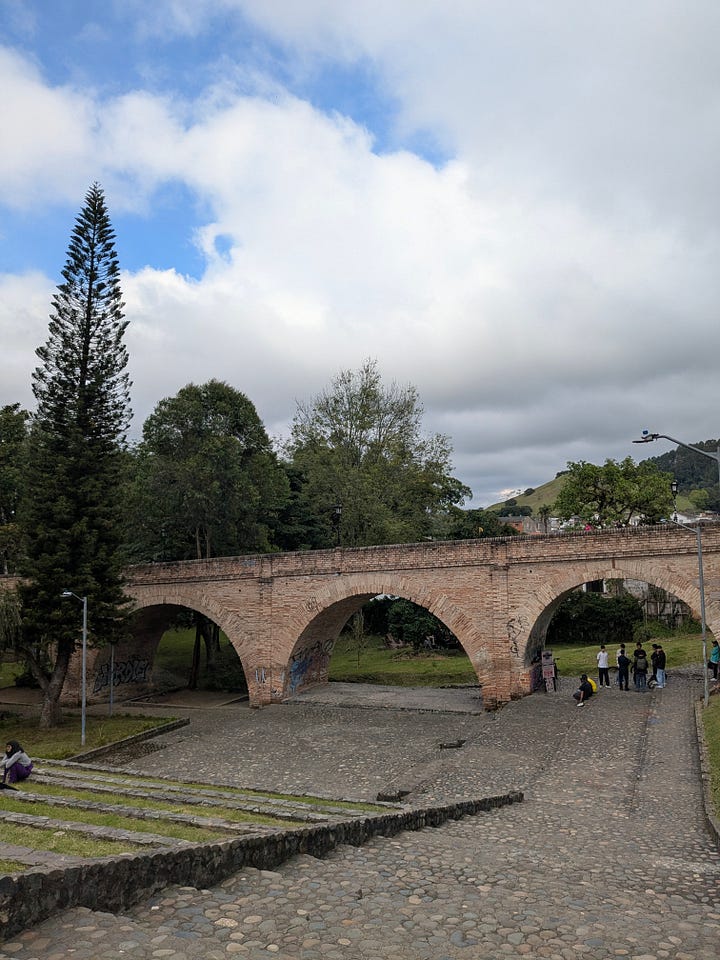
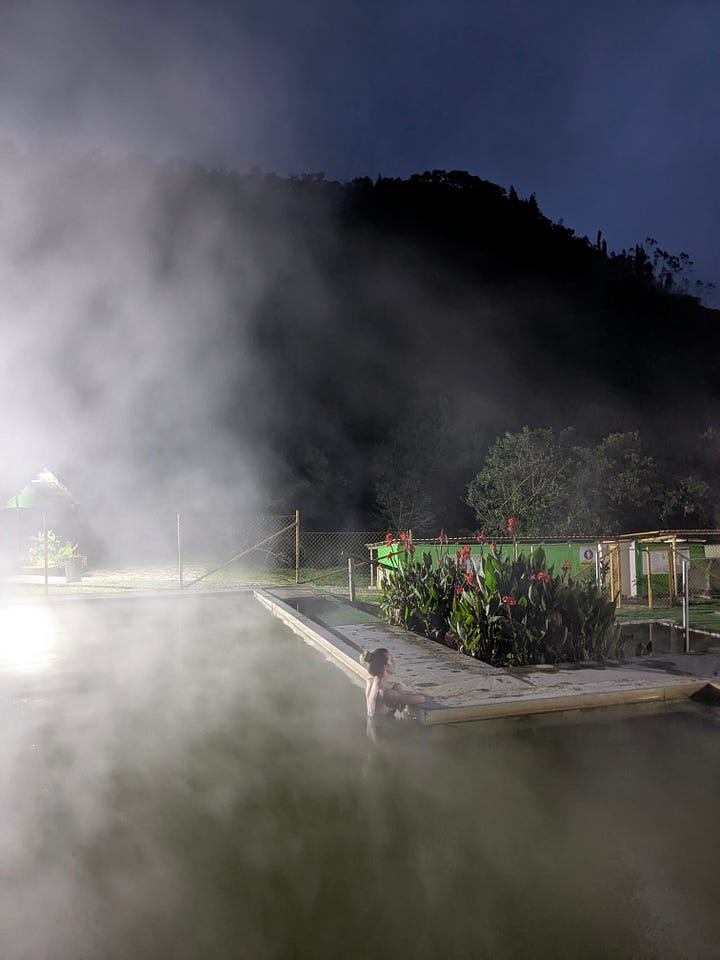
From Popayán we headed a little further north to Cali, a city with a much rougher reputation – perpetuated, famously, by its narco history. At the height of the Cali Cartel's power (1993 to 1995) they were said to have controlled more than 80 per cent of the world's cocaine market, and are also credited (if that's the right word?) with being directly responsible for bringing cocaine to Europe (according to the internet at least). These days it’s a known party town – bus loads of people arrive each weekend for the salsa scene on the city's outskirts – and I’m sure it’s true there are rough areas, but the city centre is perfectly safe tourist bait and we honestly found it charming.
The people we met in Cali were also great. Perusing the menu of a restaurant we liked the look of, we realised they didn't take card and we didn't have enough cash on us. “It's fine, just order something and pay me tomorrow,” said the large and friendly-faced chef. So we did just that. The rest of our time was spent pottering about the city, soaking up the Friday night street life and visiting its very impressive modern art museum. On Palm Sunday we took a bus from the main terminal and watched a full church service, complete with robed priests and musicians, right in the centre of the terminal building while we waited – such convenient catholicism.

Our next stop was Manizales up in the hills: a strange and not so beautiful city, but it makes a great base for visiting the nearby coffee plantations. We had a fun afternoon at the stunning Hacienda Venecia coffee farm: Dave and I had a coffee tasting last year in Lima with some visiting friends and that’s where my new love interest began. This Colombian tour was the first time either of us had been able to enjoy the stuff while being educated about it. At the end of it, our excellent guide thanked us for taking an interest and for supporting “the green side of Colombia, and not the white” – alluding of course to the country's other famous export, cocaine.
There’s no getting away from the fact that shows like Narcos have glamorised Colombia’s drugs war and brought curious fans to visit cities like Medellín as a result. Is that such a bad thing? The Colombians we’ve met so far have been quite divided on Pablo Escobar-themed tourism, some telling us that they find it distasteful and disrespectful to the victims – they’d rather it be forgotten and that people move on. While I can sympathise with the sentiment, it’s surely much better to educate people about what happened – and myth bust the Hollywood retellings where necessary, too.
Daniel from the “(Not Polite To Use His Name) Tour” (yes that’s what it’s called, I told you they’re conflicted) was very much of this latter opinion, despite the slightly clunky name. After Dave’s mystery illness, we were able to reschedule and the join the tour the following afternoon and I’m so glad – it was a lot of time spent in a minivan driving to various sites relevant to Pablo Escobar, but ultimately fascinating.
Since the end of the war, we learned, the Colombian government has been gradually reclaiming the property owned and since abandoned by cartel members. So far 48,000 buildings been seized – that’s buildings, not apartments – the most famous being the Monaco building, where Pablo and his family lived for the majority of their time. The Monaco building was left decaying and abandoned for a long time, then finally demolished in 2019, and in its place now is a memorial park – this was our first stop.
Around the park were some details of all the major bombings of banks and other state buildings orchestrated by Pablo, of which there were many, but one of the most shocking examples was in August 1989 when he bombed nine banks in one day after the chain rejected his money. Our tour guide, Danny, told us that his own parents’ house was destroyed during a street bombing three months before he was born. During the five decades of drugs wars, more than 260,000 people were killed and seven million displaced from their homes. At the end of 1989, Pablo was offering a million pesos reward for anyone who killed a police officer (more than two months’ average salary).
All quite sobering stuff, and evidence that the tour really wasn’t set up to glorify Pablo Escobar or any of the gang-related violence. But there were some very entertaining aspects all the same: a visit to La Catedral, the supposed ‘prison’ that Pablo built for himself when he volunteered to do jail time – but under his own conditions, with his own appointed prison guards – was predictably huge and garish and ridiculous. Classic narco-architecture (narchitecture?) but it’s now a retirement home, which feels like a suitable antithesis… where once there were huge parties with celebrities and footballers and prostitutes, there are now a bunch of old ladies quietly knitting and being spoon-fed refried beans.
I should say that plenty of awful things happened there, too. Danny told us that at one stage Pablo was making $1m per day – around this time it’s estimated that 20 per cent of the entire world’s circulation of dollars were in his possession. But his cartel partners were stealing up to $1m a week from him – so when he found out, he threw them in torture chamber right underneath the guest rooms at La Catedral and burned the bodies.
Danny was great. He’d grown up in the same area as Pablo and had endless lesser known anecdotes. Right at the end of our day, he casually mentioned that his own uncle was murdered after refusing to work for Pablo transporting cocaine… they’d grown up together, playing football. Our driver’s brother was also killed.
The day ended with a trip to see Pablo’s grave in what is essentially a graveyard for the rich and famous, overlooking the city. Not only was someone paying the annual fees to keep him there, but there were lots of fresh flowers on the grave – apparently fans bring them every single day. We even saw a group of three Latino guys (not Colombians, Danny was sure) arrive with a big bunch of flowers to lay down and take selfies with the grave. Totally bizarre. But then lots of people still sing Pablo’s praises, citing all the houses and schools he built, the wealth he supposedly brought to Medellìn’s poorer neighbourhoods. Like I said earlier, it’s complicated.
Danny told us he has plenty of friends and family who won’t speak to him now that he gives these tours for a living. It’s a shame, because if they only went along to one they’d see what a good job he does of telling a more rounded, truthful picture of all the terrible things Pablo Escobar did.
Travel bits and tips from this week:
In Popayán we stayed in this Airbnb, which was objectively fine and was positioned well near the old town.
The food and drink scene in Colombia has been consistently great so far. In Popayán we ate at Restaurante Carmina (good value and hearty), Mora Castilla (infamous empanadas), and Taquería la Estatal (authentic seeming Mexican). We drank at the very scenic Bar El Sotareño.
In Cali it was the proprietor of Triada Cocina Mediterránea Fusión who told us to come in and pay tomorrow. We had absolutely gigantic paellas. So good.
The boujiest terrace for coffee and sharing platters at Tierradentro.
We stayed in another Airbnb – this one was quite plush.
In Manizales, we stayed in this gloomy little basement Airbnb. Dungeon vibes and a bizarre window through to next door’s living room. We had a nice menu del día at the restaurant above it.
Cyclos resto-bar thought it was cool and casual with its build-your-own-bowl menu, but the waiter came back to our table no fewer than four times to check that I really did want a whole bowl of vegetables, and definitely not beef or pork.
We had better luck at Bretton, recommended to us by the very lovely Hacienda Venecia coffee farm owner. Good food, strong views, a little bit pricey.
Drinks at: La Azotea Rooftop in the city centre.
In Medellín we stumbled upon Trattoria di Trini for lunch – menu del día, but classy and Italian. And cheap!
Our Big Night Out began at Cerveceria La Planta, continued at Cerveceria Libre and terminated at the Mercado del Rio.
The world’s largest pizza was ordered from La Grande Pizza during Dave’s dark period. Honestly never seen a pizza so big. The best we’ve had in a very long time – we ate it all.
Our Pablo Escobar city tour was through Get Your Guide, the first time we’ve used the app but there didn’t seem to be another (cheaper) way of doing it. Highly recommend the tour, though.
We also visited the Museo Casa de la Memoria, aka, museum of memory dedicated to the country’s violent recent history (every Latin American city seems to have one).
We stayed here. RIP bathroom floor.


